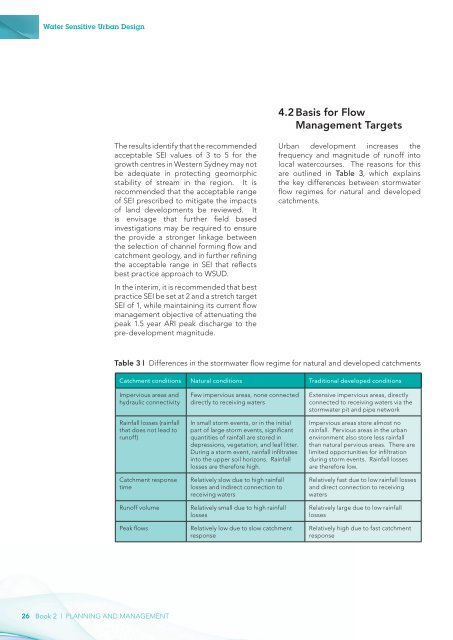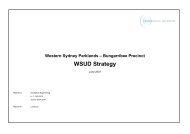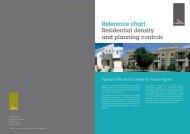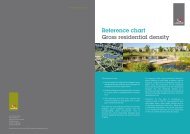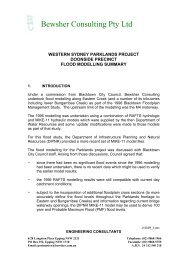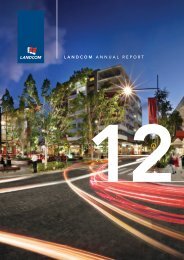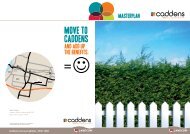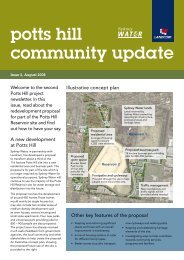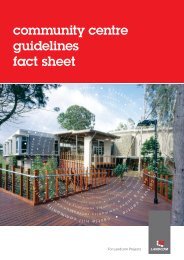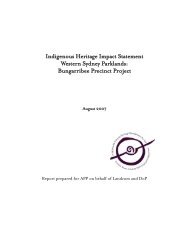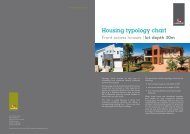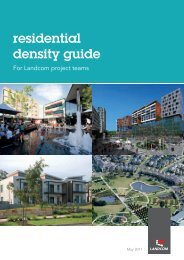Water Sensitive Urban Design
Book 2 | Planning and Management - WSUD
Book 2 | Planning and Management - WSUD
- No tags were found...
You also want an ePaper? Increase the reach of your titles
YUMPU automatically turns print PDFs into web optimized ePapers that Google loves.
<strong>Water</strong> <strong>Sensitive</strong> <strong>Urban</strong> <strong>Design</strong><br />
4.2 Basis for Flow<br />
Management Targets<br />
The results identify that the recommended<br />
acceptable SEI values of 3 to 5 for the<br />
growth centres in Western Sydney may not<br />
be adequate in protecting geomorphic<br />
stability of stream in the region. It is<br />
recommended that the acceptable range<br />
of SEI prescribed to mitigate the impacts<br />
of land developments be reviewed. It<br />
is envisage that further field based<br />
investigations may be required to ensure<br />
the provide a stronger linkage between<br />
the selection of channel forming flow and<br />
catchment geology, and in further refining<br />
the acceptable range in SEI that reflects<br />
best practice approach to WSUD.<br />
In the interim, it is recommended that best<br />
practice SEI be set at 2 and a stretch target<br />
SEI of 1, while maintaining its current flow<br />
management objective of attenuating the<br />
peak 1.5 year ARI peak discharge to the<br />
pre-development magnitude.<br />
<strong>Urban</strong> development increases the<br />
frequency and magnitude of runoff into<br />
local watercourses. The reasons for this<br />
are outlined in Table 3, which explains<br />
the key differences between stormwater<br />
flow regimes for natural and developed<br />
catchments.<br />
Table 3 | Differences in the stormwater flow regime for natural and developed catchments<br />
Catchment conditions Natural conditions Traditional developed conditions<br />
Impervious areas and<br />
hydraulic connectivity<br />
Rainfall losses (rainfall<br />
that does not lead to<br />
runoff)<br />
Catchment response<br />
time<br />
Runoff volume<br />
Peak flows<br />
Few impervious areas, none connected<br />
directly to receiving waters<br />
In small storm events, or in the initial<br />
part of large storm events, significant<br />
quantities of rainfall are stored in<br />
depressions, vegetation, and leaf litter.<br />
During a storm event, rainfall infiltrates<br />
into the upper soil horizons. Rainfall<br />
losses are therefore high.<br />
Relatively slow due to high rainfall<br />
losses and indirect connection to<br />
receiving waters<br />
Relatively small due to high rainfall<br />
losses<br />
Relatively low due to slow catchment<br />
response<br />
Extensive impervious areas, directly<br />
connected to receiving waters via the<br />
stormwater pit and pipe network<br />
Impervious areas store almost no<br />
rainfall. Pervious areas in the urban<br />
environment also store less rainfall<br />
than natural pervious areas. There are<br />
limited opportunities for infiltration<br />
during storm events. Rainfall losses<br />
are therefore low.<br />
Relatively fast due to low rainfall losses<br />
and direct connection to receiving<br />
waters<br />
Relatively large due to low rainfall<br />
losses<br />
Relatively high due to fast catchment<br />
response<br />
26 Book 2 | planning and management


